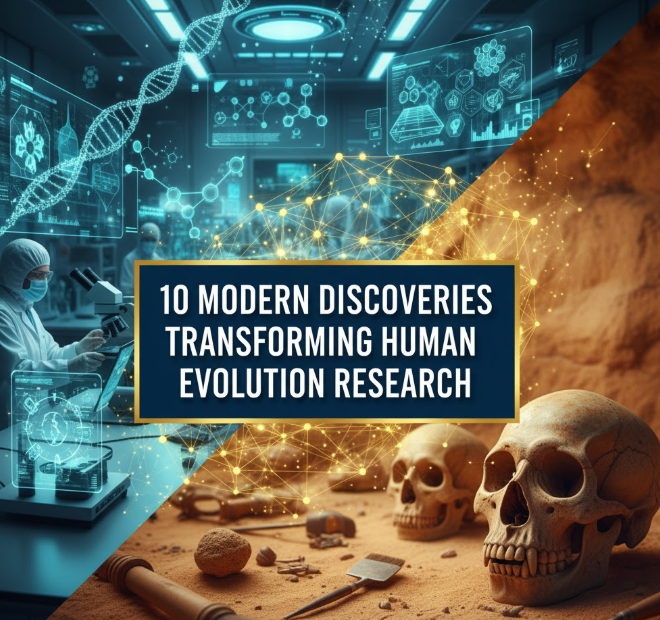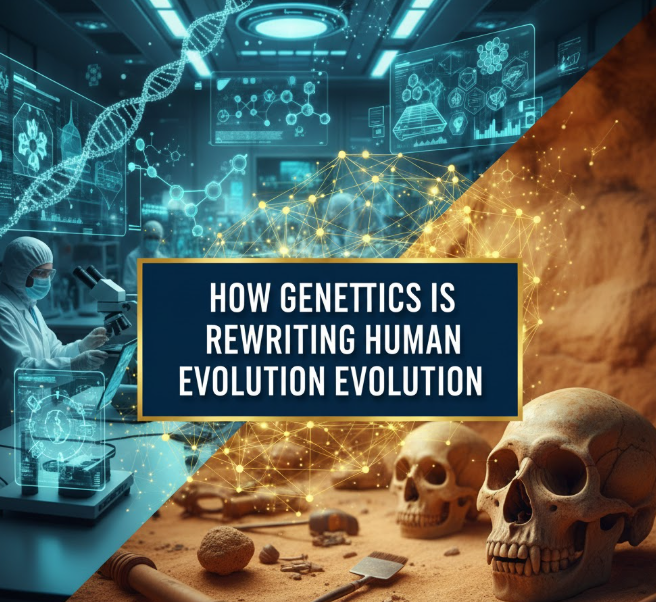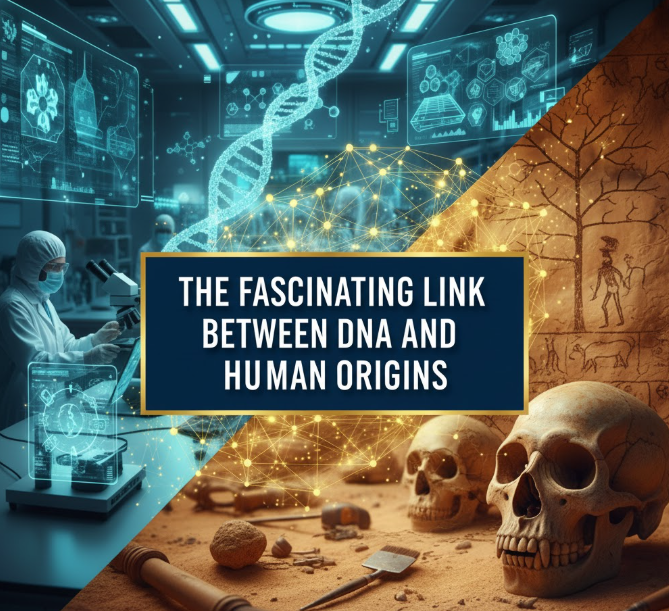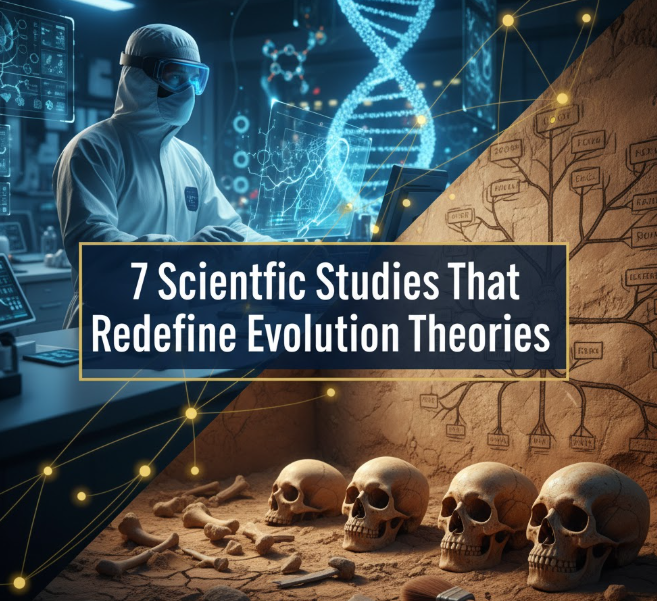The story of how we have come to be who and what we are will become ever more fascinating. Every year, it seems, scientists find new snippets of DNA echoing in our genes and are interpreted as coming from archaic or otherwise unknown relatives. From ancient DNA in caves to surprising discoveries about our extinct cousins, modern technology is helping us answer questions that once seemed impossible even a decade ago.
Here is a look at ten of the most significant and recent findings that are helping to redefine what we know about the origins of our species. These findings batter down old theories, connect us to ancestors we didn’t even know we had, and show just how related all humans are to people who lived many hundreds of thousands of years ago. Whether you are a science buff or just interested in figuring out where the heck we humans come from, these revelations are sure to have you seeing our shared history in a whole new light.
1. Modern Humans Carry Denisovan DNA
by Gregory Cooper
Researchers in other words are not strangers to foreigners, but many years back in 2008 they found a small finger bone and a tooth from an unknown species in a cave located in Siberia. That tiny bone turned out to be part of an entirely new kind of archaic human we hadn’t known existed: the Denisovans. What’s extraordinary about this discovery is that we’ve found only a few Denisovan bones, and yet they lived across Asia and even slept with our ancestors.
Here’s why this finding is so significant: Many people alive today have Denisovan DNA in their genomes. If any of your ancestors lived in Southeast Asia, Papua New Guinea or Australia anyone with this heritage slightly more than three percent but less than five percent of the DNA transferred from that wandering human to you. This genetic material isn’t just sitting there idle — it actually helps some people survive better at high altitudes, by regulating their ability to process oxygen.
The Denisovan find proved to scientists that humans didn’t evolve in a straight line from apes. Instead, various types of humans overlapped in time and space, encountered one another and interbred. This mingling of genes made us more resistant to diseases and allowed us to better adapt to different environments we encountered across the world.
How Scientists Study Denisovan DNA
Researchers are able to extract ancient DNA from bones and teeth, and then compare it to the DNA of living humans. They can tell:
- Where Denisovans lived
- Who they interbred with
- And whatever traits they bequeathed us
- Their strategies for adapting to their environment
2. Homo Naledi: The Cave Discovery That Changed Everything
Back in 2013, a pair of cavers were digging around deep underground somewhere in South Africa when they made an incredible discovery — a chamber filled with more than 1,500 ancient human bones. The bones come from Homo naledi — a species that has scientists scratching their heads because it is so different-looking from us, modern humans.
Homo naledi had a peculiar combination of traits. Their brains were puny — about the size of an orange — just like some very old human ancestors. But their hands and feet were remarkably modern-looking. The biggest surprise came when scientists dated the bones and discovered that they were but 236,000 to 335,000 years old. That means Homo naledi coexisted with early modern humans, who had much larger brains.
The find raises fascinating questions: Could a creature with such a small brain make tools, use fire or even bury their dead? The location of the cave in which they were discovered is also evidence of intentional burial, and therefore that Homo naledi had to have complex thoughts even though it only had a little, child-sized brain. That flies in the face of our belief that only big-brained humans were capable of symbolic thought or had culture.
3. Ancient DNA from Dirt Tells Stories of Lost Populations
One of the coolest advances in recent years is that scientists can now pull human DNA from soil and sediment — no bones required. This process, known as sediment DNA analysis, is akin to finding the genetic fingerprints of people who lived thousands of years ago.
In caves once inhabited by ancient humans, they left behind DNA in skin cells, hair and more. That DNA falls into the soil and can persist for hundreds of thousands of years. Using this technique, scientists have identified different species of human that lived at separate times in the same caves — even when they haven’t found any bones.
This discovery is revolutionizing archeology, because bones are scarce — but dirt is everywhere. Researchers can now study ancient populations even in regions where no skeletons exist. From DNA in ancient trash piles, they can tell who lived where, when and even what animals they hunted.
| Source of DNA | Information It Provides | Oldest Age Limit |
|---|---|---|
| Bones and teeth | Direct genetic data, physical traits | Up to 400,000 years |
| Sediment/soil | Population presence, species identification | Up to 240,000 years |
| Cave deposits | Diet, animals present, climate data | Varies widely |
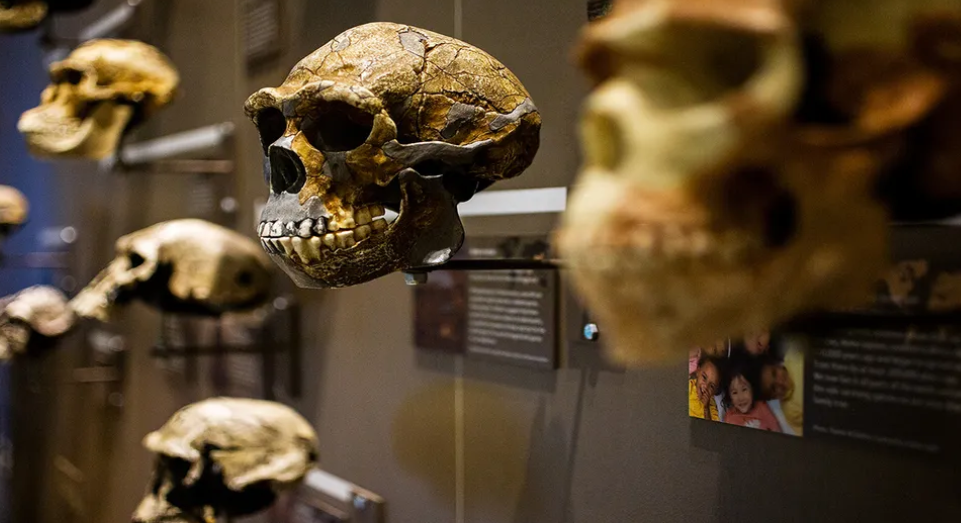
4. Real Hobbit People in Indonesia
In 2003, researchers discovered bones from tiny prehistoric humans that were about the size of hobbits on the Indonesian island of Flores. At 3.5 feet tall, they were known as “hobbits,” after the race of people in J.R.R. Tolkien’s books. Initially, many scientists assumed they were just modern humans with a disease that kept them small. But further investigation revealed that they were in fact a distinct species, dubbed Homo floresiensis.
The hobbits were walking Earth just 50,000 years ago, and may have overlapped with our own species. Even with their tiny bodies and little brains (their brains are one-third the size of ours), they fashioned stone tools, hunted pygmy elephants and managed to last hundreds of thousands of years on their island home.
This discovery demonstrated that human evolution was more varied than we thought. It also showed that smallness could be an asset on resource-limited islands — a phenomenon known as island dwarfism. The hobbits show you don’t need a bulging brain to succeed: all you need to do is thrive in your environment.
Why Size Doesn’t Determine Intelligence
The hobbits of Flores have valuable lessons for us:
- Brain size isn’t the only measure of what your brain can do
- Different environments favor different traits
- Human evolution generated more diversity than we thought
- Small brained species did use tools and had culture
5. Interbreeding Was Common, Not Rare
For many years, scientists thought that when modern humans moved out of Africa about 70,000 years ago, they completely replaced other hominins without mixing with them. This theory has been totally debunked by new genetic evidence. Our ancestors, it seems, were a lot more social with other human species than we had realized.
Our modern human DNA is a mash-up of at least three other distant ancestors: the Neanderthal, Denisovan and possibly other hominin species which are yet to be discovered. If you are of European or Asian descent, about 1-2% of your DNA comes from Neanderthals. People from Oceania have as much as 5 percent Denisovan DNA. Some groups even carry DNA from now-extinct “ghost” species that we’ve encountered so far only through their genes, not fossils.
And it wasn’t a freak one-off — it happened multiple times at different places. What’s more, the genes we received weren’t simply random. And many of them helped our ancestors survive. Some of those Neanderthal genes helped to improve our immune system, adapted us to cold environments, and even impacted the characteristics of our skin and hair. In other words, the handshake and hanky-panky with our fellow human species was a case of survival making us stronger.
-
☀️ Learn more: How Climate Shaped the Course of Human Evolution
6. Humans Departed Africa Far Earlier Than We Thought
Every few years, scientists push back their estimate of when humans first left Africa. Recent finds in China, the Middle East and Southeast Asia proved that humans had ventured far earlier into the world than a traditional theory could account for.
A human jawbone dating to 177,000-194,000 years old has recently been found in Israel in an astonishing discovery that will overturn ideas of the origin of our species. Stone tools and what may have been evidence of human remains from 100,000 to 120,000 years ago are among other sites in China. These finds indicate that there were several waves of migration, not just a single great exodus.
Some of these early migrants left no descendants in modern populations — they died out, or were absorbed by later waves. But their existence outside of Africa at such dates push back our migration timeline entirely. It implies that our ancestors were much more adventurous and mobile than we’d credited them. We didn’t suddenly wake up 70,000 years ago and decide to leave Africa — we had been exploring and attempting to settle new lands for tens of thousands of years prior to that.
7. Ancient Art and Symbolism Came Well Before Previously Thought
For decades, scientists thought complex thought and art didn’t spark until humans matured in Europe around 40,000 years ago. This Eurocentric understanding was broken down by recent findings in Africa, Asia and elsewhere.
In South Africa, researchers found a trove of symbolic behavior dating back 100,000 years that included shell beads and engraved ochre along with sophisticated tools. Researchers in Indonesia found cave art they determined to be at least 44,000 years old — just as old as any of the famous cave paintings in Europe. Even more astonishing, there is some evidence that Neanderthals made art, and used pigment for decoration.
The results show that the ability of symbolic thinking, creativity and culture is not the preserve of a particular population or time period. People all around the world were making art, producing jewelry and symbolically representing themselves long before we’d previously thought. This would move back the roots of human culture and imply that the cognitive capacities that make them “modern” developed early in humans, not suddenly, in one place.
Timeline of Symbolic Behavior
| Time Period | Location | Evidence |
|---|---|---|
| 100,000+ years ago | South Africa | Shell beads, engraved ochre |
| 75,000 years ago | Kenya | Ostrich shell beads |
| 65,000 years ago | Spain | Neanderthal cave paintings |
| 44,000 years ago | Indonesia | Hand stencils, animal art |
| 40,000 years ago | Europe | Cave paintings and sculptures |
8. Climate Change Influenced Human Evolution More Than We Thought
In decades past, scientists paid far more attention to physical evolution — how we and our bodies had evolved. But now research is revealing that climate change also played a major role in human evolution. When the climate shifted, humans either adapted or went extinct.
Climate models and findings from archaeology show that big shifts in human evolution keep happening during episodes of incredibly rapid change. For example, the evolution of larger brains in our ancestors coincides with times when Africa grew drier and food supplies shifted. Man had to grow smarter to discover food in more difficult terrains.
The most intriguing is on variation. It was not just cold periods or warm periods that were important — it was fast climate movements. In a fast- and unpredictable-changing environment, it was exactly those humans who could adapt, innovate and problem-solve that survived. Those who couldn’t adapt disappeared. This climate instability, in fact, may have selected for the adaptability and creativity that defines humans today.
Learn more about human evolution and climate change at the Smithsonian’s National Museum of Natural History.
9. Fire’s Role Changed Everything
The discovery of fire isn’t new, in other words, but what we’ve learned recently about when people began to control fire has profound implications. New evidence from sites in South Africa indicates that humans were using fire some 170,000 years ago — which is a hundred thousand years earlier than archaeologists previously estimated.
Controlled fires were transformative to human evolution in many ways. By cooking food, more nutrients were released and less energy was needed for digestion, and that in turn gave our brains the opportunity to grow larger. The discovery of fire and, as a consequence the warmth it brings, allowed humans to move into colder climates. It kept away predators and expanded the day with light after dark. Fire even served as a social center where families gathered, told stories and transmitted knowledge.
Our timeline has been pushed back significantly with the revelation in recent years of ancient hearths, burned bones and heated stones at archaeological sites throughout Africa and Asia. Some researchers now believe that it was mastering fire that was the key invention to separate us from other primates and perhaps led us down a path toward modern humans. Without fire, we might never have thought our way into big brains and large vocabularies; to say nothing of the chance it gave us to spread like sparks light up a landscape.
10. Genetics Exposes The “Ghost” Populations We’ve Never Discovered
Maybe the most bizarre discovery of recent years is that scientists can now tell when and where extinct human populations lived based solely on their genes — people for whom we have never found a single bone. These “ghost” populations appear as odd patterns in the DNA of modern humans that can’t be explained by any formally recognized species.
With the help of elaborate computer models, researchers can attempt to trace the ancestry of modern populations and discern areas where unknown groups may have contributed DNA. For instance, a former archaic human group that broke off from our lineage more than 600,000 years ago left its genetic mark in the genomes of West African populations. We’ve found similar ghost populations in Asian/Pacific Islander genetics.
It’s like finding the footprints of someone who has walked by but is not around. We may never recover bones or artifacts from these populations, but we can tell they were there because they left their footprints in our genes. The finding shows that the human family tree is more complex than had been suspected, and likely carried more branches than we can probably still discover, but added to who we are today.
How Scientists Detect Ghost Populations
Researchers use these methods:
- Compare DNA from present day humans in various regions
- Search for genetic patterns that do not correspond to any known ancient humans
- Model mixing with computers to simulate mixing scenarios
- Determine when and where these ghosts lived
- Calculate how much they contributed to modern DNA
Why It Matters: These Findings Have Broader Implications
These 10 discoveries are more than just fun facts for scientists — they alter our very collective self-image. They reveal human evolution to be messy, complicated and much more interesting than a straight line from ape to human. We weren’t the only humans on Earth for much of our history; we lived alongside cousins like the Neanderthals, Denisovans and hobbits.
The findings also suggest that all living humans today are related to one another, carrying bits and pieces of DNA from these various ancient populations. No human “pure” lineage—we are all mixed. This scientific reality undermines racist theories about superior or inferior race, because we’re all literally cousins who share the same complex ancestries.
Lastly, these results demonstrate just how malleable humans can be. Our ancestors made it through ice ages, periods of drought and radical climate shifts. They made things up, and they figured things out. That same flexibility and innovation lives on in us today, which is heartening as we confront our own crises, from climate change to environmental degradation. Knowing where we came from helps us decode what comes next.
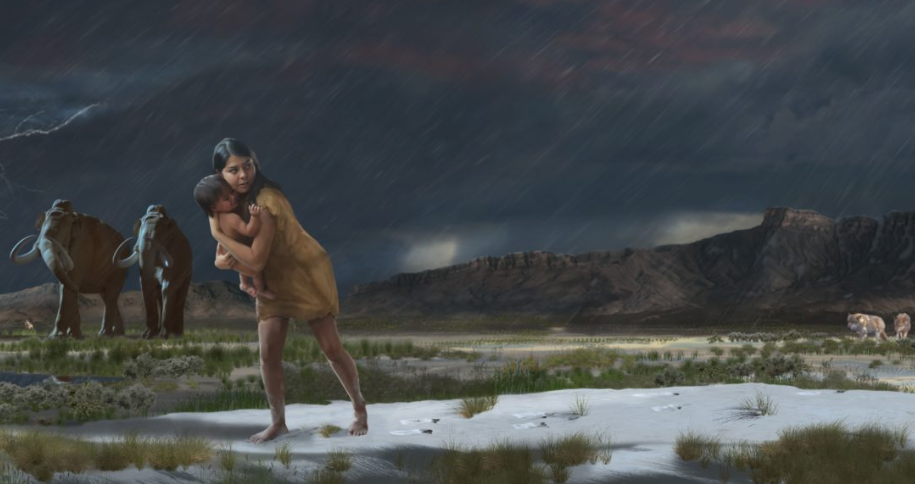
Frequently Asked Questions
Q: How do researchers get DNA from ancient bones?
Researchers drill into bones or teeth to get powder, and then employ chemicals to extract DNA. They must be done in sterile labs, as ancient DNA is fragile and readily polluted with modern DNA. The DNA is then sequenced with powerful computers that can read even flawed genetic material.
Q: Could Neanderthals and Homo sapiens speak with one another?
This is a matter of debate, but available evidence indicates that Neanderthals had the physical capability to speak. They possessed a hyoid bone (crucial for speech) and the FOXP2 gene, which is linked to language. It is unknown whether they had fully modern language, but they likely communicated in complex fashions.
Q: Why did Neanderthals die out if they were smart and strong?
A number of factors likely played a role: climate change, competition with modern humans for resources, smaller population sizes that left them vulnerable, and perhaps diseases carried by modern humans. It probably wasn’t a single cause but a medley of challenges.
Q: Are there any unknown species of human still to be found?
Possibly! New species of ancient human are discovered all the time, and mysterious populations like ghost types can be found in DNA. There are even a few remote caves or sections that remain partially unexplored. Perhaps fossil discoveries yet to be made on the island will more directly represent unknown human relatives.
Q: What is the oldest human ancestor ever found?
That depends on what you mean by “human”. If you’re referring to the genus Homo itself (which we belong to), that’s around 2.8 million years old. If you’re talking about the hominins (animals that are closer to us than to chimpanzees) that dates back to around 6-7 million years ago with fossils like Sahelanthropus.
Q: How much more Neanderthal DNA do some people have than others?
Most non-African populations carry 1-2% Neanderthal DNA, although some individuals have a little more or less. Percentages are slightly higher for East Asians than Europeans. African populations have little or no Neanderthal DNA because their ancestors did not interbreed with Neanderthals outside of Africa.
Q: Will we ever be able to clone a Neanderthal?
This raises enormous ethical issues and is infeasible with technology that exists today. Despite the fact that we have a Neanderthal genome, we don’t have intact cells or eggs required for cloning. Most scientists would say that this shouldn’t be done even if it’s technically possible for moral reasons; making a person without their consent who would be completely alone in the world is unethical.
Q: How do scientists determine the age of fossils?
Depending on the age of the fossil, they employ various dating methods. Carbon dating is good for objects up to 50,000 years old. In older fossils, they use techniques including uranium-series dating, argon-argon dating and luminescence dating of surrounding sediments. Ages are typically verified through a number of methods.
The Future of Research in Human Evolution
Never has the field of human evolution research moved so quickly. New technologies, including the analysis of ancient DNA and high-resolution imaging of fossils, as well as computer modeling of climate at a hitherto unthinkable level of detail has made it possible for scientists to ask and answer questions that would have been unimaginable just 20 years ago.
We will undoubtedly find more extinct species of humans, older bones with evidence of art and culture, and other details about how these groups interacted. Each find contributes another piece to our puzzle of where we came from and what it means to be human.
What’s even more exciting, however, is that anybody can follow along. New discoveries are always being announced and presented in laymen’s terms. The story of human evolution is not over — it’s being written today, with new chapters added constantly.
The next time you gaze into a mirror, think of the person looking back at you as the cumulative consequence of millions of years of evolution, climate change, migration and breeding between different human populations. You harbor DNA from ancient populations who lived before the spread of cities and writing. You’re part of a really long story — one that scientists are still piecing together, but one that tethers all human beings in all times and places. And that’s something worth appreciating.

